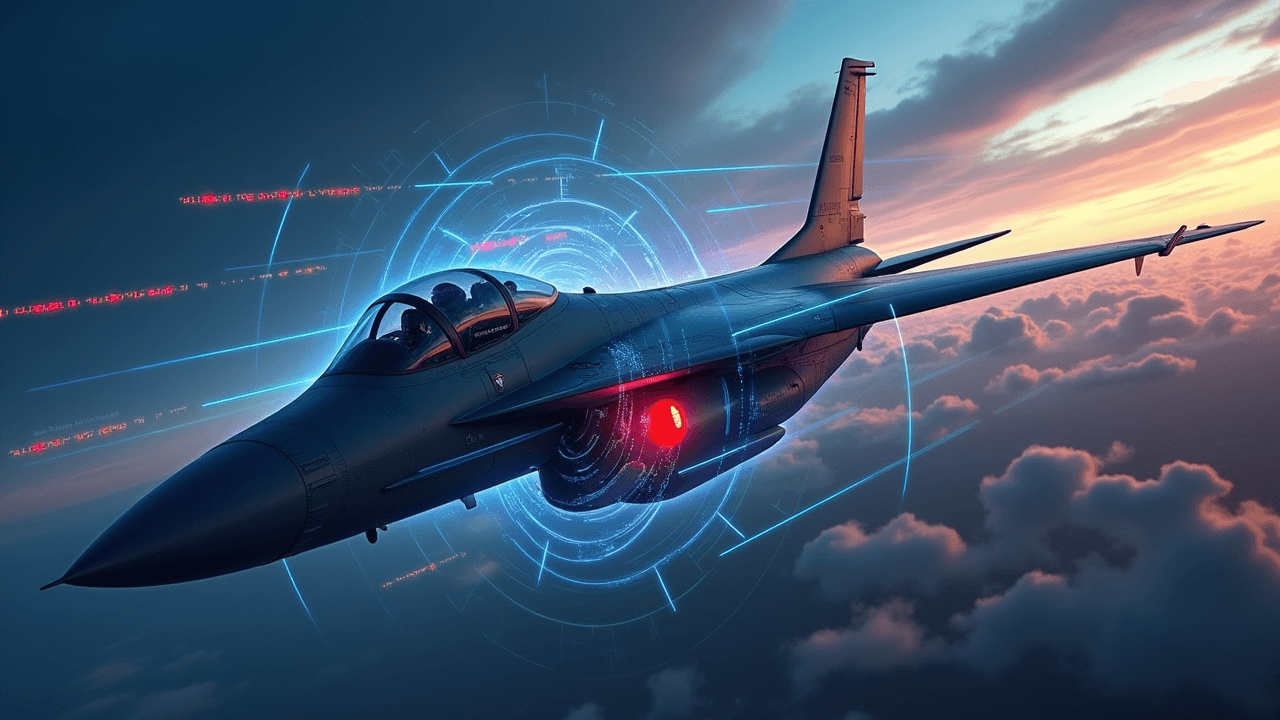Ever catch yourself wondering what’s going through a pilot’s head when that missile warning screams at them? I bet that gets the heart rate up. No kidding. Today, we’re diving deep into the system that’s supposed to give them a heads up: radar warning receivers, or RWRs for short.
Understanding Radar Warning Receivers (RWRs)
It’s a great question because there’s a lot of misunderstanding about what an RWR can actually do. And from what I’ve gathered, it’s definitely more complicated than just “Yep, you’re about to be a target.”
The Technological Tango Between Radar and RWR
It’s way more nuanced, like this whole back and forth—a technological tango between the radar trying to stay hidden and the RWR working like mad to pick it out.
I get the basic idea: an RWR picks up radar signals, right?
Exactly. But let’s talk about search modes, track modes, all these different radar signals. Honestly, it’s a lot to process.
Radar Modes and Their Impact on RWRs
It really is, and you’re right to zero in on those modes because that’s where it gets interesting and crucial for a pilot.
Search Mode: The Casual Glance
Think of it like this: in search mode, a radar is basically someone scanning a crowded room. Their glance might land on you for a second, but they’re not really focused.
Okay, just checking things out. No biggie, right?
And that’s what an RWR is picking up most of the time—those quick glances. So just general radar awareness, nothing to freak out about yet.
Track Mode: The Laser Focus
But then things ramp up to track mode.
You got it. Now that radar is locked on you. It’s gone from casual scanning to a laser pointer fixed on your chest, gathering precise data on your speed, your heading, your altitude—basically anything it needs to paint a target on you.
And that’s when the alarms go off.
I’m starting to see why they call it electronic warfare.
The Evolution of Radar and RWR Technology
Absolutely. It’s a constant chess match. As radar evolved to be stealthier, RWRs had to keep pace, getting more advanced in how they decode those signals.
Low Probability of Intercept (LPI) Radars
Let’s talk about something called LPI radar—Low Probability of Intercept. Stealthy stuff, right? It’s designed to be exactly that: hard to detect.
Someone once described traditional radar as a flashlight, and then LPI as like a dozen Christmas lights, a strobe light, and a flashlight that’s sometimes green, sometimes a UV black light, sometimes infrared—you need a special camera for it.
That’s actually a perfect analogy because that’s exactly how LPI radars operate. They try to vanish into the background noise by spreading their energy across tons of frequencies or using these really short, intermittent pulses.
AESA Radars: The Ninjas of the Radar World
Then, to make matters even trickier, we’ve got AESA radars—Active Electronically Scanned Arrays.
Yep, those are even sneakier. AESA radars are a game-changer. They’re incredibly hard for those traditional RWRs to get a lock on.
Older radars send out this continuous beam, kind of like the flashlight we mentioned earlier, sweeping back and forth. But AESA radars use thousands of tiny antennas all working together to send out super-focused beams of energy.
So instead of one flashlight beam, it’s more like a whole swarm of fireflies, all blinking on and off.
Exactly. And those beams can jump around crazy fast, changing frequency on the fly, which makes them a nightmare for traditional RWRs.
The Importance of Intelligence in Electronic Warfare
It’s not just about knowing what frequency to look for, but when and where to look in all that signal chaos—like trying to find a specific snowflake in a blizzard.
Okay, that’s just not fair. No wonder even having a top-notch RWR is only half the battle. Knowing your enemy’s radar systems—that intel seems just as important.
Absolutely. Even the most advanced RWR is only as good as the information it has. They rely on this whole database of known radar signatures. Think of it like a fingerprint library, but for radar.
So if the RWR picks up a signal but it’s not in its fingerprint database, you might not know what you’re dealing with. Could be harmless, could be a serious threat. No way to tell.
It’s like showing up to a costume party where you don’t recognize any of the masks. You have no idea who’s about to hand you a drink or, you know, pull a prank.
That’s a great way to put it. And that’s why gathering signals intelligence—that intel—is absolutely vital in electronic warfare.
Real-World Implications of Radar Locks
By collecting data on enemy radar systems—like what frequencies they use, their waveforms, even how often they switch things up—you can basically program your RWRs to spot those threats and give your pilots a fighting chance.
So it’s like having a playbook for the other team’s defense, knowing their formations, their tells.
That’s a great way to think about it. And it’s not just about offense, either. This whole cat-and-mouse game has huge consequences in the real world. Even locking onto an aircraft during peacetime, even accidentally, can be a big no-no.
Yeah, that makes sense. Things could escalate quickly. But why is a radar lock such a big deal if, say, no one’s actually firing missiles?
Well, think about it. Because of how easily things could be misinterpreted, a radar lock—even without firing—is seen as an act of aggression.
Like, imagine cruising down the highway and some car pulls up next to you. They’re not swerving or anything, but the person’s pointing a gun at you.
I’d be freaking out.
Exactly. And in the air, the stakes are, well, sky-high. A radar lock is basically saying, “I see you and I can take you out.” It amps up the tension big time.
Historical Examples and Tactical Innovations
So it’s a tightrope walk. You want to gather intel, keep your own forces safe, but you don’t want to spook the other side by accident.
That’s the core of it. It shows how this tech stuff isn’t just about gadgets and gizmos. It’s also about how we communicate, how easily signals can get misinterpreted, especially when everyone’s on edge.
The Vietnam War and Radar Tricks
Speaking of on edge, there’s this chilling story about how those extra seconds of warning from an RWR can be the difference between life and death. Something about the Vietnam War and the Viet Cong messing with their radar systems.
Ah, yeah, that’s a classic example of using your enemy’s tech against them. It shows how even limitations in technology can be exploited if you’re clever enough.
So the Viet Cong would deliberately lower the power output of their SA-2 missile radar systems.
Why would they do that? Wouldn’t that make their radars less effective?
You’d think so, right? But see, this little trick played on a weakness in the older RWR tech. Remember how we talked about signal strength being a kind of yardstick for distance?
Yeah, stronger signal, closer to the threat.
So by dialing down their radar power, the Viet Cong tricked American pilots into thinking those missiles were way farther away than they really were.
Oh wow, that’s sneaky—like they were whispering into the radar waves instead of shouting.
Exactly. A low-tech solution to a high-tech problem. And it worked because it exploited a blind spot in the technology at the time. By the time those American RWRs sounded the alarm, it was often too late.
Man, that’s a sobering thought. Really drives home the point that even the best tech is only as good as the person using it.
The Future of Electronic Warfare
Couldn’t agree more. Sometimes a clever tactic can be more effective than having the fanciest gear.
The Arms Race Continues
So where does this leave us? Are radars gonna get so stealthy they’re basically invisible, or will RWR tech always find a way to catch them?
That’s the million-dollar question, right? It’s an arms race, plain and simple, each side trying to outmaneuver the other. But one thing’s for sure: this whole electronic warfare thing is going to keep getting more complex, more important in future conflicts.
AI and the Next Generation of RWRs
Oh, what’s next? Are we talking AI-powered RWRs that can think for themselves?
Oh, absolutely. AI is definitely on the horizon. Imagine a system that’s constantly learning, adapting to new threats in real-time, updating its own radar fingerprint database.
So the RWRs of the future will be learning and evolving faster than we can even design them.
That’s the goal. Although it’s not just about AI, either. Researchers are looking into other wild stuff too, like passive sensors.
Passive Sensors and Beyond
Passive sensors? What’s that?
So instead of listening for radar signals, these things pick up on other stuff—heat, electromagnetic emissions, things like that. Not radar itself, but telltale signs that something’s out there.
Sneaky. So it’s like even if you manage to mask your radar, you might still be giving off other clues.
Exactly. It’s getting harder and harder to hide in the electromagnetic spectrum. And that’s where things get really interesting, because it’s not just about detecting the enemy anymore; it’s about fighting back. And that’s where electronic countermeasures come in—ECMs.
Electronic Countermeasures (ECMs)
ECMs? Okay, we’re going deeper down the rabbit hole here.
Think of it like this: if detecting a radar signal is like hearing a watchdog bark, ECMs are all about either convincing that dog you’re actually a cat or teaching it to bark up the wrong tree.
Okay, that’s an image I won’t soon forget.
Deception and Illusion in Electronic Warfare
So we’re talking about deception, creating these illusions on the radar screen.
You got it. Some ECMs jam the enemy’s radar with just overwhelming noise, basically blinding them. Others create false targets, making it look like there are multiple aircraft when it’s really just one.
Like those old war movies, dropping chaff or flares to throw off those heat-seeking missiles.
Same idea, but way more high-tech. We’re talking about creating these super-sophisticated electronic signals that can mimic a real aircraft or even make a ghost image that seems to be flying a totally different path.
So you’re not just hiding; you’re messing with their whole reality.
The Ethical and Strategic Implications
That’s wild. So you’re saying that future air battles might not be about who has the fastest jets or the biggest bombs, but about who can win this electronic warfare showdown.
It’s definitely a growing factor. As we lean more and more on technology for warfare, being able to control that electromagnetic spectrum—to see without being seen, to strike without being vulnerable—that’s going to be key.
The Virtual Battlefield
It’s not just about the physical battlefield anymore but about dominating that virtual one too.
Dominating the virtual battlefield—man, that’s both fascinating and kind of scary, like something out of a sci-fi movie, except it’s our reality now. And like with any tech that powerful, there are some big ethical questions we’ve got to figure out. Like, how much control do we hand over to AI? What are the rules of engagement in that virtual world?
We’re still figuring all that out. It’s a lot to consider, but I think this deep dive gave everyone a good grasp on the basics—at least how those RWRs work and the constant back and forth of electronic countermeasures.
Final Thoughts on Electronic Warfare
We’ve learned it’s not just about the tech itself, but about the ingenuity, the strategy behind it all—that constant race to innovate, to outsmart the other guy, and the ethical questions that pop up when you’re talking about virtual battlefields and AI calling the shots.
And the human element is still at the heart of it all.
Absolutely. This deep dive has really given me a lot to think about.
For everyone reading, next time you’re in your car, take a look at that little antenna—the one that picks up your favorite radio station. It’s a distant relative of the tech we’ve been talking about today. And just like those RWRs in fighter jets, it’s a good reminder that we’re surrounded by these invisible signals.
Yeah, the airwaves are buzzing with them, each one carrying information—information that can be used for good or, you know, not so good. So next time you’re scrolling through your phone or using your GPS, just remember: the same tech that connects us can also be used to mislead, to manipulate, to wage war in ways we’re only just beginning to grasp.
FAQ
Can Radar Warning Receivers (RWRs) tell when you’re locked on?
Yes, RWRs can detect when a radar has shifted from search mode to track mode. In track mode, the radar is focused on gathering precise data about your aircraft, and that’s when the RWR alarms go off, alerting the pilot of a potential threat.
What is the difference between search mode and track mode in radar systems?
In search mode, a radar scans broadly without focusing on any specific target, like someone glancing around a room. In track mode, the radar locks onto a specific target to gather detailed information, indicating a higher level of threat.
How do Low Probability of Intercept (LPI) radars avoid detection?
LPI radars spread their signals across a wide range of frequencies and use short, intermittent pulses. This makes them blend into background noise, making it difficult for traditional RWRs to detect them.
Why is intelligence gathering important for RWR effectiveness?
RWRs rely on databases of known radar signatures to identify threats. Gathering intelligence on enemy radar systems allows RWRs to recognize and respond to new threats effectively, giving pilots a better chance of evading danger.
What are Electronic Countermeasures (ECMs) and how do they work?
ECMs are tactics used to deceive or jam enemy radar systems. They can overwhelm radars with noise, create false targets, or mimic aircraft to confuse the enemy, effectively blinding or misleading their radar detection capabilities.
Your Hosts

Alex & Maria
Join Alex Thompson and Maria Davis as they navigate the fascinating world of knowledge. With their combined expertise and passion for learning, they simplify the complex and make every episode a journey worth taking.

